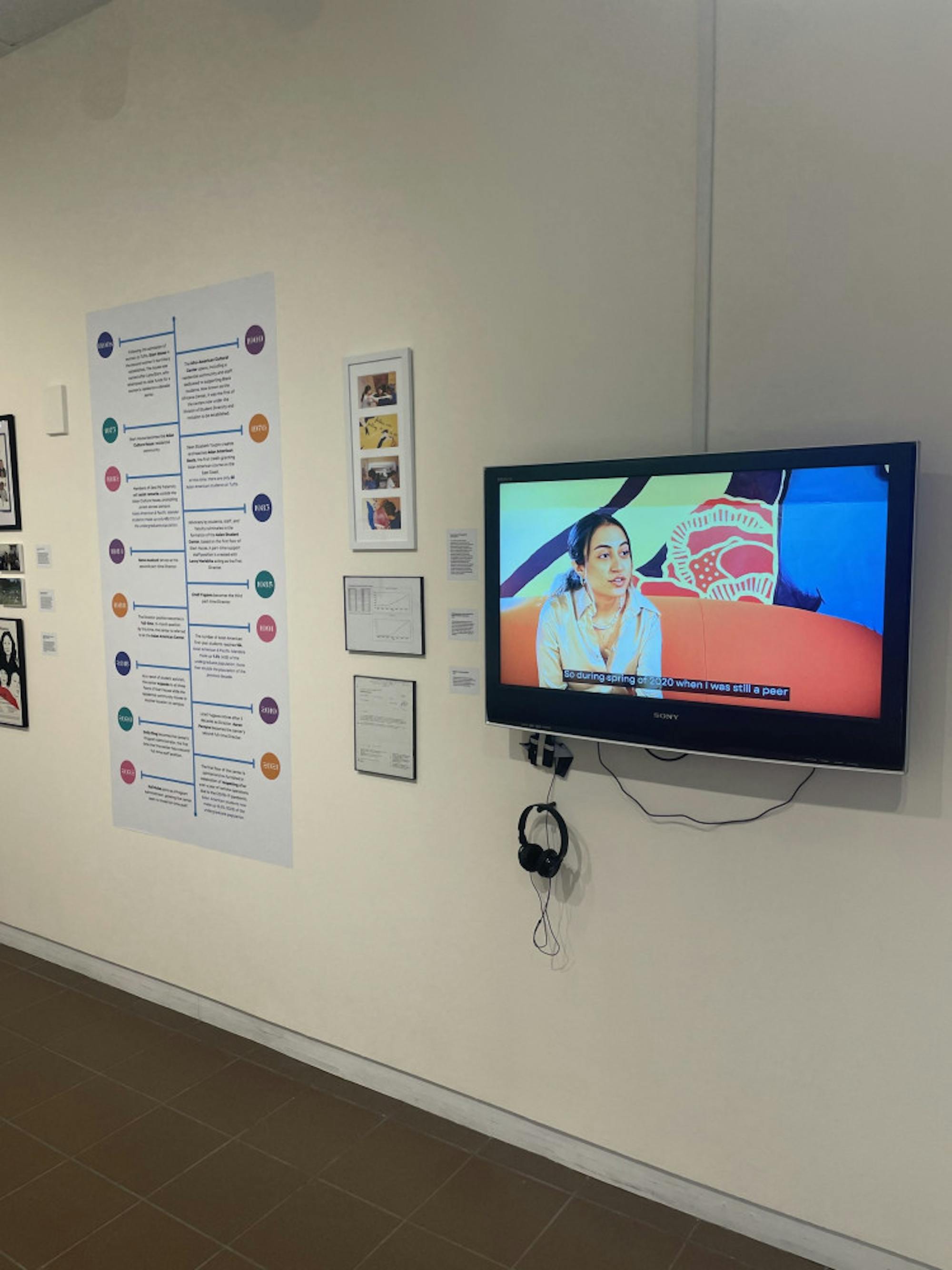Tufts University's Asian American Center is one of the oldest Asian American centers to be established on a college campus. Currently, there are only about 40 centers of its kind around the United States.This year marks the center’s 40th anniversary and the “Our Histories, Our Futures” exhibition meditates on the AAC’s legacy and contributions of Asian Americans at Tufts.
Curated by AAC graduate assistant and AAC associate director Yuuki Nishida and Emily Ding, respectively, the exhibition utilizes a multimedia format. The east wall of the exhibition is composed of archival materials, exploring the history of the AAC and the circumstances that led to its creation. It includes photographs of previous AAC members and staff, newspaper clippings, pamphlets for previous AAC events and graphs detailing the growth of Asian Americans at Tufts, demonstrating the AAC’s presence and participation in student life. The archival materials are supplemented by a timeline marking pivotal dates in the AAC’s history. The east wall also includes filmed interviews with Tufts alumni sharing their experiences attending the university and reflecting on the impact that the AAC had on their experience at Tufts.
In an email to the Daily, co-curator Yuuki Nishida explained the inspiration behind the exhibit.
“Part of our theme, ‘Our Histories, Our Futures’ forces us to reflect on the past and honor those whose activism led us to where we are today,” Nishida wrote. “A lot of what the center is today has been a result of student-led activism. It’s important to include the voices who were a part of that.”
In dealing with the history of the AAC, the exhibition grapples with the difficult circumstances that ultimately lead to its formation. In 1982, in response to an incident where racist remarks were made by Zeta Psi fraternity members outside of the Asian cultural house, students, staff and faculty advocated for the formation of an Asian Student Center. In 1983, the AAC was established.
The gallery's west wall displays paintings, photography and assemblage, contributed by current Tufts students, reflecting on the influence and impact of cultural values and experiences on identity. At the opening ceremony for the exhibition, the artists were invited to speak about their work.
Reina Matsumoto, a senior whose photograph “Mother and I” is currently on display at the exhibition, shared her artistic process and perspective with the Daily.
“Being Japanese American has always informed my photography,” Matsumoto wrote. “I think I only really started to understand how at the beginning of college when I was able to learn more about Asian American identity and experiences. … I thought a lot about how rare it is to have media that represents Asian and Asian Americans and their relationships in a nuanced way and the ways that white supremacy and society shape our ideas of beauty. So in my work, I really want to combat that, by showcasing my friends and family in the ways they'd like to be represented.”
The exhibition provides an opportunity for members of Tufts’ Asian American community to share their artwork,explore their identity and reflect on how their cultural histories and hopes for the future intertwine and influence their identity.
“It’s important to carve out spaces for BIPOC students in a predominantly white institution to allow them to unabashedly be themselves and uplift each other,” Nishida wrote. “I think of art as a tool for liberation. Marginalized folks have historically used art to fight back against racism, injustice, and inequality, but also to celebrate the strength and beauty of their communities.”
Matsumoto echoed this sentiment.
“[This exhibition] provides a chance for the Asian and Asian American community to come together and celebrate how far we’ve come, and how much more there is for us to do,” Matsumoto wrote. “These galleries also show how our community is filled with people from different backgrounds with different experiences, but how we can still come together over some element of shared identity. At a [predominantly white institution] like Tufts, it can feel so comforting to know there is a space for us, and a chance to celebrate some great art and artists.”
While the exhibition celebrates the accomplishments and contributions of the AAC and the Asian American community at Tufts, it also serves as a reminder of the importance of continued initiatives for social justice and cultural representation. Tufts students are currently petitioning for the expansion of Asian American studies after the university revealed that no Asian American Studies courses would be provided in the coming fall semester.
“Still, even with all this work and the resources available to us at Tufts now, there is room for growth,” Matsumoto wrote. “For example, students are currently fighting for more resources, faculty and classes for Asian American studies and are working so hard to build community. … It’s through the work of previous Asian Americans at Tufts that we were able to get the center, to have the few classes we have, and eventually get the minor. Now, we can carry their work with us, and fight for even more. This gallery reminds us to celebrate the legacy of community care and student organizing in the past and encourages us to keep fighting and maintain hope for the future.”
The exhibition will be on view at the Slater Concourse Gallery in Aidekman Art Center until April 14.






